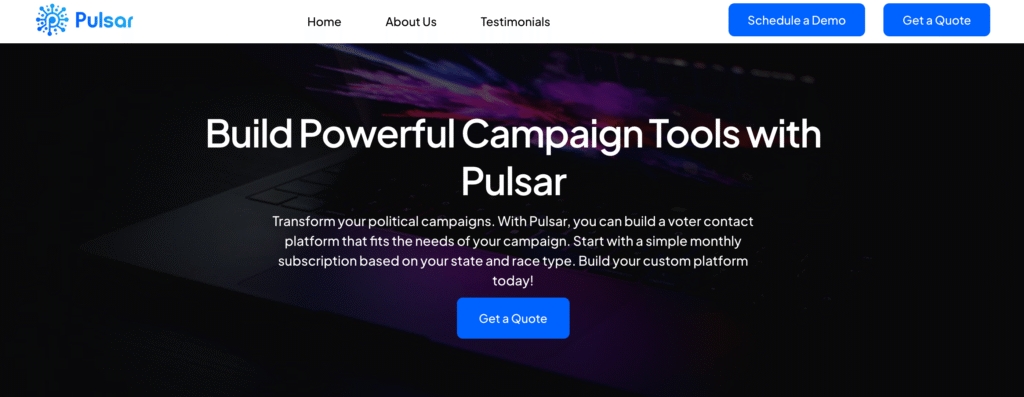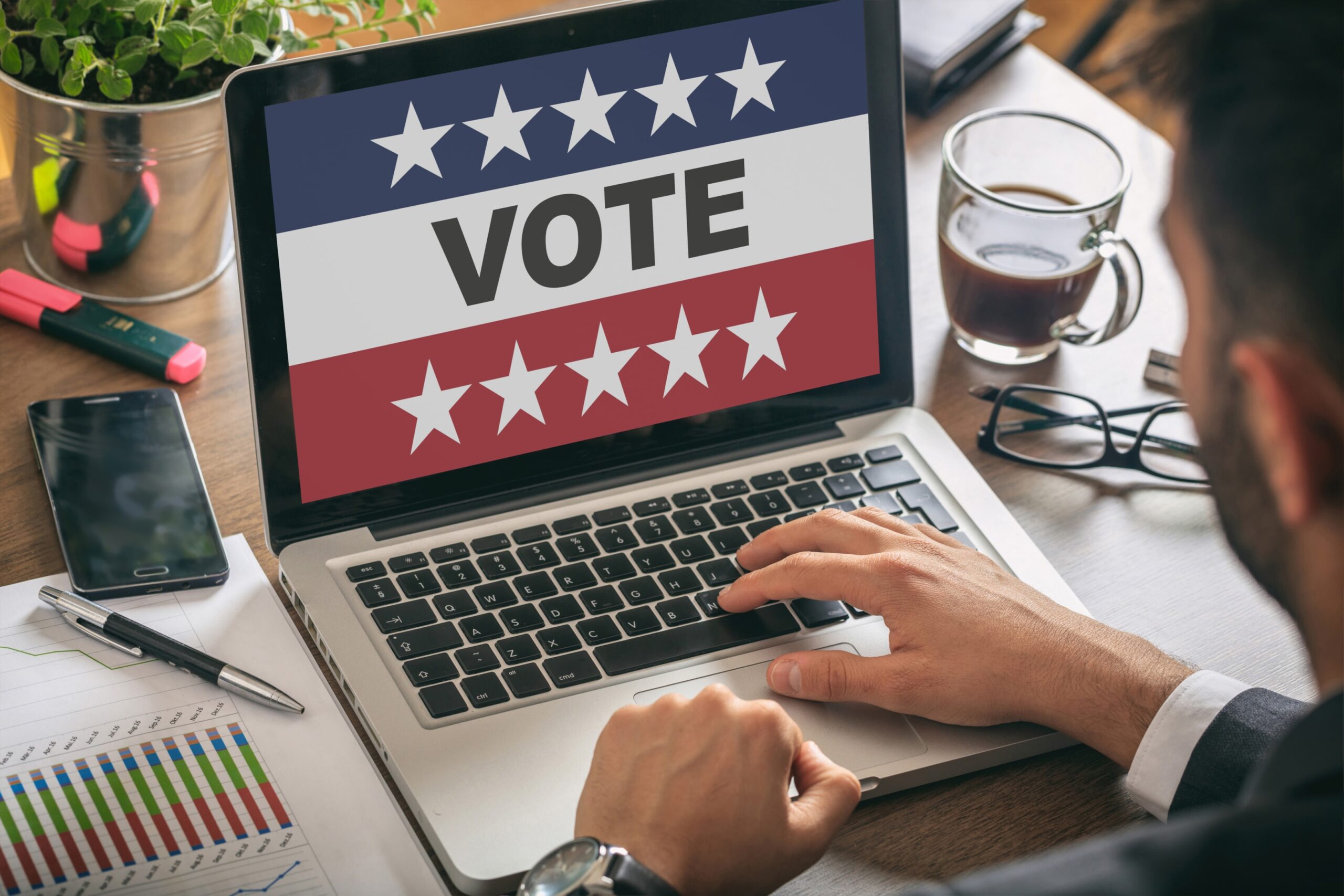Every campaign competes for attention, and few channels reach voters as effectively as text messaging.
Notifyre reports that 81% of Americans use texting regularly and send more than six billion messages each day. This level of activity makes SMS one of the most dependable tools for reaching supporters and increasing voter turnout.
This guide explains what political texting is, how it works, and why it has become an essential part of modern campaigns.
What Is Political Texting?
Political texting helps campaigns reach voters on their mobile devices. Instead of hoping someone opens an email or sees an ad, a text message appears instantly on the screen.
Campaigns use political text messages to:
- Remind voters about events or election day
- Share donation links and raise contributions
- Provide updates on campaign priorities or local issues
- Send voting information and registration details
Texts also open a line of communication. Recipients can reply, ask questions, or confirm attendance. Each exchange gives campaigns valuable data about voter preferences.
That information helps refine future election campaign messages and keep the audience engaged.
Benefits of Sending Political Text Messages
Political texting helps political campaigns reach potential voters, drive contributions, and manage campaign goals. Some of the main advantages are:
- Increase fundraising: SMS helps raise more contributions through concise political campaign texts that include donation links. Voters can act quickly, which helps campaigns meet financial goals before deadlines.
- Collect relevant data: Campaigns can collect data from responses to understand voter preferences and measure engagement. These insights help refine future political messaging and improve audience targeting.
- Keep voters engaged: Regular texts maintain interest and build trust. Campaigns can send reminders, answer questions, and keep voters informed about priorities leading up to polling day.
How to Write Effective Political Campaign Texts
Writing effective political text messages requires precision. Each message should inform, motivate, and guide voters toward action.
Follow these steps to write texts that get attention, respect voter preferences, and help you meet your campaign goals.
Keep Messages Short and Focused
Texts must be brief and purposeful. Voters read messages quickly, so limit each one to about 160 characters. Start with your campaign name, explain your purpose, and end with a clear action.
For example:
“Hi Jordan, this is the Miller for Congress campaign. Vote early this week at your local polling center.”
Avoid filler or background details that distract from the point. A focused message respects the reader’s time and improves response rates.
Be Honest and Transparent
Always identify your campaign or candidate right away. Explain the reason for your message. For instance, confirm an event, remind voters about election day, or ask for a donation.
“Hi Laura, this is Tom from the Jackson for Senate team. Can we count on your vote this election?”
Messages that clearly identify the sender reduce confusion and help your campaign stay compliant with texting laws. Honesty also builds trust between your campaign and voters.
Personalize Messages to Connect With Voters
Personalized texts create stronger engagement. Address recipients by name and mention something that relates to their location or concerns.
If your data shows a specific region cares about education or taxes, reference those topics to make your message relevant.
Here’s an example:
“Hi Alex, Senator Davis will meet residents at Northfield City Hall this Saturday at 10 AM. We would love to see you there.”
A personal message feels genuine and reminds voters that your campaign understands their priorities.
Send Messages Only During Appropriate Hours
Timing can determine whether a voter reads or ignores your message. The Telephone Consumer Protection Act (TCPA) allows messages only between 8 AM and 9 PM local time.
Aim for late mornings or early evenings when voters are likely to check their mobile devices.
If your campaign covers several states, schedule messages according to each time zone. Respecting timing rules helps your campaign maintain compliance and avoid complaints.
As election day approaches, increase your reminder frequency slightly but avoid sending too many messages. Too much contact can frustrate voters and lead to opt-outs.
Include a Clear Call to Action
Every message should guide the voter toward one specific step. Use short and direct instructions that are easy to follow.
Examples:
“Reply YES to volunteer.”
“Click this link to donate $10.”
“Show this message when you check in to vote.”
Keep your call to action simple. Don’t combine multiple requests in one message. A single, focused instruction helps your campaign track engagement more accurately.
Follow Compliance Rules
Following the TCPA is mandatory. Always obtain consent before sending messages and include an opt-out option such as “Reply STOP to unsubscribe.”
This ensures your campaign respects voter privacy and maintains a positive reputation.
Send messages only to verified voters in your database. Keep records of all opt-ins and responses to prove your campaign complies with regulations.
Noncompliance can result in fines and, more importantly, loss of voter trust.
Segment and Analyze Campaign Data
Use your data to divide voters into smaller, targeted groups. Send relevant updates to each segment, such as donation requests to past contributors or event invitations to active volunteers.
This increases engagement and ensures messages reach voters most likely to respond.
Monitor performance after each campaign. Track response rates, link clicks, and engagement trends to see what resonates. Adjust timing and message tone based on what the data reveals.
Encourage Voter Interaction
Texting shouldn’t be one-sided. Encourage two-way communication to strengthen voter relationships. Ask short questions that invite participation.
Example:
“Hi Mark, this is the Rivera for Congress campaign. What issue matters most to you this election?”
Voter responses provide insight into public concerns and help your campaign refine future political text messages.
Test The Message Before You Send It
Before sending texts to your entire contact list, test a small batch first.
Review how the message appears on different mobile devices and confirm that all links work. Check names, dates, and event information carefully to avoid mistakes.
Testing ensures your message is accurate and delivered successfully. Once you confirm everything is correct, send the final message to your full audience.
Consistency and attention to detail reflect professionalism and strengthen voter confidence in your campaign.
Mistakes to Avoid in Political Text Messaging
Even experienced campaigns can lose voter trust or waste resources if they overlook basic rules. These mistakes often weaken political text messages and reduce voter engagement.
Avoid them to keep your campaign compliant, professional, and organized.
- Using outdated or inaccurate data: Incorrect or old data leads to wrong names, invalid numbers, and wasted effort. Keep your voter list updated and accurate to maintain credibility and stay organized.
- Skipping message testing: Test every text before a full send. Check how it appears on different mobile devices, verify that links work, and confirm event details. Careful testing helps avoid errors that can confuse or misinform voters.
- Using inconsistent messaging: Messages that sound disconnected or contradict previous texts can reduce trust. Keep tone, timing, and message content consistent across your political text campaigns to create a unified voice.
- Failing to keep records: Keep detailed records of voter consent, text history, and response logs. Documentation shows compliance with the law and helps your campaign stay transparent and organized.
How to Evaluate Political Text Message Results
Once your campaign sends texts, you should measure performance to understand what drives engagement and where to adjust your strategy.
The following data helps campaigns make decisions that lead to better communication and voter turnout.
Track Core Metrics
Foci on metrics that reveal voter behavior:
- Delivery rate: Confirms that texts reached valid numbers. Low rates may mean your voter list has outdated or incorrect data. Keep it current to avoid wasted effort.
- Response rate: Shows how many voters reply or act after reading your text. A high rate often means your message was relevant or well-timed. Compare results from different text types to find what drives stronger engagement.
- Click-through rate: Measures how many recipients clicked on links for donations or events. For instance, if one in five recipients clicked a donation link, that text likely motivated action.
- Opt-out rate: Indicates whether your tone or timing discourages participation. High opt-outs suggest your campaign should adjust message frequency or content.
Compare Results Across Campaign Goals
Each type of text serves a different goal. Fundraising texts perform best near donation deadlines, while reminders about events or polling dates gain attention as Election Day nears.
Compare results between message categories to see which aligns with your objectives. If donation messages outperform others, study what made them successful.
On the other hand, if event reminders underperform, adjust your timing or content to better match voter priorities.
Test Messages to Find What Works
Testing helps campaigns refine messages before reaching large audiences. Send two versions to different voter groups. Change one detail, such as the opening word, message time, or call to action.
For example, one version could say, “Hi Sarah, this is the Grant for Congress team.” The other could say, “Sarah, Grant for Congress here.” Compare the results. See which version earns higher response rates.
These small adjustments can improve engagement and build stronger voter interest. Campaigns that test consistently keep messages relevant and organized.
Review Data and Adjust Strategy
After each text campaign, analyze your results carefully. Data highlights trends that reveal what voters care about and how they react.
If your platform shows that donation texts perform well but event reminders lag, adjust your focus. If engagement drops, shorten your message or shift send times. These changes help keep your audience attentive.
Politicians who review their results often make informed decisions that improve campaign performance. Regular analysis ensures every text contributes to stronger voter communication and dependable results.
When campaigns track progress and refine their outreach, they connect better with advocates, donors, and voters across all message types.
Expand Your Campaign Reach With Pulsar’s Voter Contact System

Political texting is most effective when supported by the right tools. Pulsar brings everything your campaign needs into one dependable platform. It helps teams organize voter contact, manage volunteers, and track progress with precision and ease.
The platform combines door-to-door canvassing, phone banking, and texting in one seamless experience.
Campaigns can access preloaded voter data through the powerful political CRM. They can also assign routes and track engagement with accuracy. Each feature works together to keep teams coordinated and ready to act.
Whether your race is statewide or local, Pulsar provides the support needed to reach voters and manage campaign operations. More than 120,000 campaigns and 40,000 users have trusted Pulsar to raise funds and boost voter turnout.
Ready to grow your campaign reach? Schedule a free demo or get a quote to see how Pulsar can help you reach every voter on your list!
FAQs About Political Texting
What is political texting?
Political texting helps political candidates and parties communicate directly with voters through text messages. Campaigns use it to share updates, promote events, and encourage participation before polling day.
It’s faster and more personal than mail or email, helping campaigns reach supporters quickly.
How does peer-to-peer texting work?
Peer-to-peer texting connects voters with campaign volunteers through one-on-one phone conversations.
Each message comes from a real person, not automation, which builds trust and reduces the risk of being flagged as spam. This format helps voters feel more connected and encourages genuine interaction.
What are the legal rules for political texting?
Campaigns must follow the Telephone Consumer Protection Act, or TCPA. This law requires campaigns to get consent before sending texts and to include an option to unsubscribe.
Following these rules keeps organizations compliant and protects voter privacy during the campaign.




